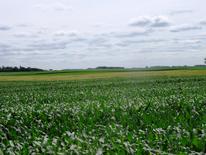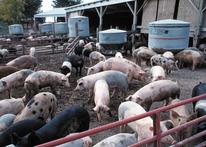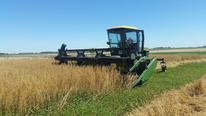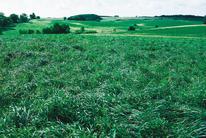By Gigi DiGiacomo
Edited by Kristine Moncada, Craig Sheaffer and Nicole Tautges
Bryan and Theresa Kerkaert grew up in Lyon County, Minnesota. Bryan was a “town kid” who helped out on his uncle’s farm. “I’ve always loved plants,” Bryan says. “Even when I was a kid, I dreamed of growing crops.” Theresa grew up on a dairy farm nearby.
Bryan and Theresa married in 1991 and had hoped to farm right away. However, they struggled to find land that they could afford. Instead, Bryan worked for his uncle full-time, assisting with fieldwork, cattle management, and other farm chores. Theresa became a stay-at-home mom to take care of their busy family of four boys.
Six years later Bryan and Theresa purchased seven acres from his uncle and erected hog barns on the site. In 2001 Brian left his position with his uncle to purchase and manage a manure pumping/hauling business. As Bryan’s business grew, he began traveling to low-input and organic farms. “Every time I was out on an organic farm, I asked questions and tried to learn,” recalls Bryan. “I had the chance to see [organic farmers’] rotations, learn from their successes, and from their mistakes.” These daily visits fed Bryan’s long-time passion for crop farming and inspired his interest in organic management.
Bryan and Theresa again began exploring the idea of purchasing tillable acreage or nearby
land with a farmstead. They didn’t want to move out of the district where their four sons were attending school, so they were limited geographically to finding land relatively close by.
After several years of searching, the Kerkaerts had all but given up. In 2007, however, Bryan was offered a long-term lease for 160 acres of land located 35 miles from their home. The landowners were brothers who had hired Bryan to spread manure on their fields. No chemical inputs or prohibited substances had been applied to the land in years. Bryan and Theresa immediately signed the five-year cash rental agreement and were able to certify the land quickly.
Renting rather than owning the land wasn’t the ideal situation, but it allowed the Kerkaerts to try their hand at organic crop production. They borrowed equipment from a well-established organic farmer who Bryan knew growing up, and planned a rotation that would allow them to capture organic premiums right away - beginning with corn, followed by oats under-seeded with alfalfa, followed by another year of alfalfa.
Evolving the Organic Operation
Over the years Bryan and Theresa gradually took on more rental acreage, accumulating 1,300 acres by 2013. They farmed organically on any land coming out of CRP or that for which they could secure long-term, fixed cash rent leases. Land with short-term leases was farmed conventionally.
“If we could sign long-term leases on everything I’d farm it all organically,” Bryan says. “There is no sense of accomplishment farming with chemicals. But I can’t plan rotations or count on reaching [organic] certification with the short term leases – it’s too risky so we have to go conventional [on short lease land].”
Problems with Managing Rental Land Organically
Where long-term leases could not be obtained, the Kerkaerts tried managing land coming out of CRP on short-term leases with the idea that they would be able to certify immediately. CRP land is eligible to be certified as organic if it can be documented that no chemicals or other prohibited substances have been applied to the land for the past three years or more. However, they found that CRP land is not the best choice for short-term agreements when undergoing the transition to organic. In fact, in the Kerkaert’s experience, it has taken them a minimum of three years following initial tillage to establish good, profitable yields on CRP land. “There’s a reason that the land was put in CRP,” says Bryan. “Nutrient availability can be really low and there are weeds - lots of weeds [on CRP parcels that we transitioned].”
Following their struggles with short-term leases, the Kerkaerts decided to farm organically with long-term leases. However, the Kerkaerts have continued to run into problems. Farmland rental rates in Lyon County have increased every year since the Kerkaerts started farming organically. Land rents increased by 5 to 20% or more annually during 2007 to 2014, making it very difficult to turn a profit – especially during the transition period when yields often take a dip. Increases in land rents tend to reduce the availability of longer-term contracts (landowners don’t want to lock themselves into long-term contracts with fixed rents as this would limit their ability to take advantage of annual increases in rent and income).
The Kerkaerts would like to secure more long-term leases and eventually purchase land that would allow them to farm everything organically. Bryan and Theresa estimate that they’ll need at least 480 acres to establish a good organic rotation, cover overhead expenses associated with machinery ownership, and meet their living expenses. However, they have continued to search for farmland with no luck. Available land is either located too far away or is cost prohibitive.
Similar to rental rates, farmland prices (reported as sales price) in Lyon County have skyrocketed over the past nine years, increasing 137 percent from 2007 to 2015. In Minnesota as a whole, farmland prices have risen 87% on average between 2007 and 2013 from $2,724/acre to $5,111/acre (Lazarus, 2016). Prices softened a bit during 2014 and 2015, averaging $4,895/acre. The Kerkaerts would have needed to finance an estimated $2.35 million to purchase 480 acres of productive farmland in 2015.
The Kerkaerts may no longer continue farming if they cannot secure long-term, permanent access to good farmland that can be certified organic. They desperately want to farm organically but feel they have hit too many walls trying to transition rental land.
Should the Kerkaerts give up on organic management and farm conventionally until they find land to purchase? Should they reconsider renting and farming land as it comes out of CRP? How might they make this work? What are the risks of renting land with short-term leases? Should they negotiate crop share options, flexible land rents, or higher rental rates in exchange for long-term leases? If they can’t obtain long-term leases, should they keep farming organically?
Access the complete decision case study with all educational materials (pdf) >>>
You may cite this publication as:
DiGiacomo, G.2017.Transitioning on Rented Land. A Decision Case Study in Principles for Transitioning to Organic Farming: e-Learning Materials and Decision Case Studies for Educators. K. Moncada, C. Sheaffer, and N. Tautges (Eds). University of Minnesota, St. Paul, MN.



